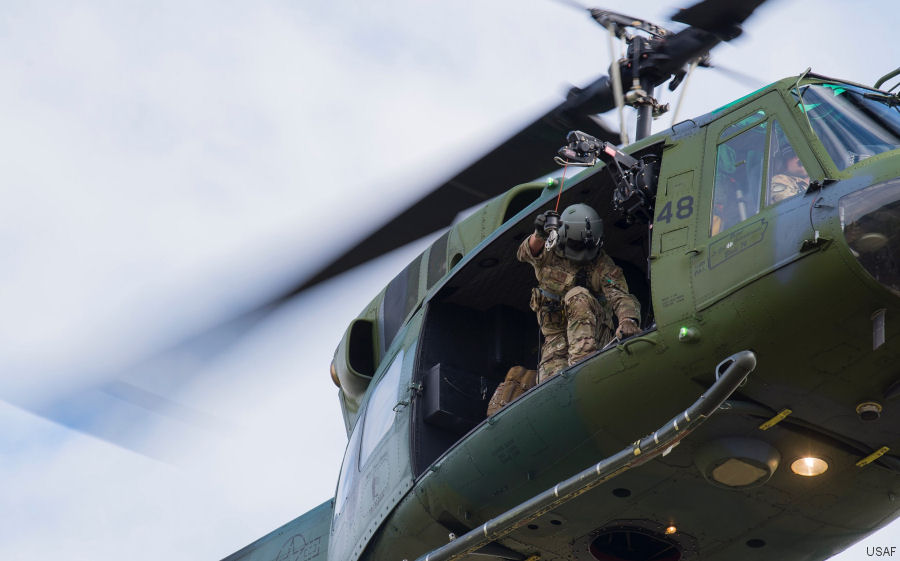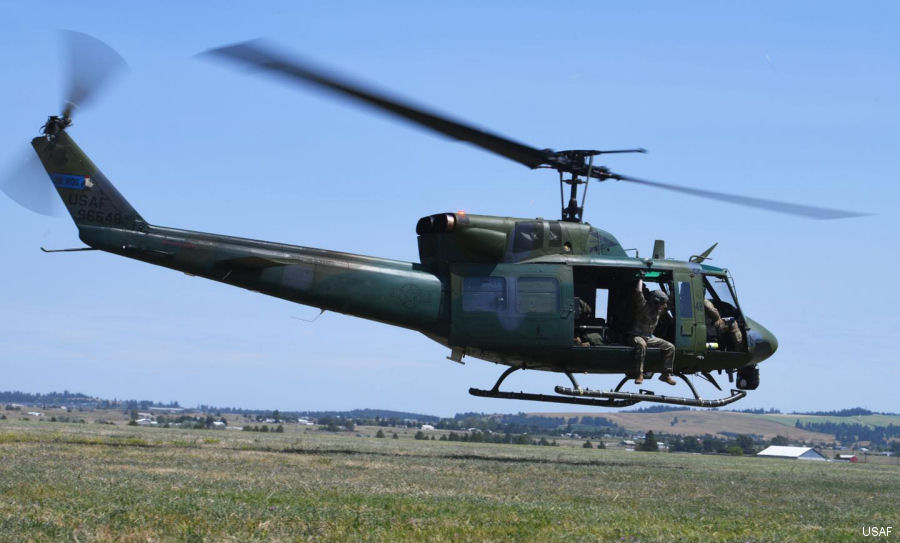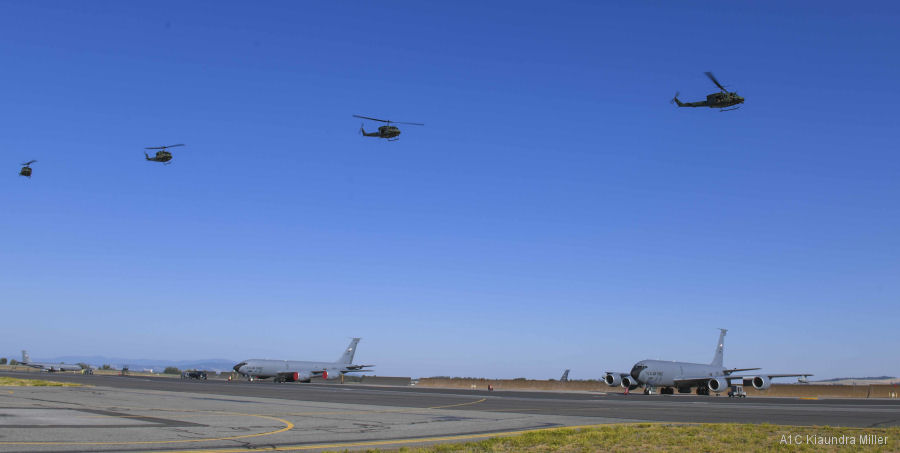
US Air Force, August 08, 2021 - FAIRCHILD AIR FORCE BASE, WA by Airman 1st Class Kiaundra Miller - The 36th Rescue Squadron celebrated 50 years of operations, here, July 15, 2021.
The 36th RQS’ primary mission is to support the United States Air Force Survival, Evasion, Resistance and Escape (SERE) School training through hands-on helicopter operations for over 4,000 students per year; however they also support local civilian agencies in search and rescue operations and participation in safety investigations.
“We provide the community with a safety blanket, knowing that if they need us, we'll be there,” said Lt. Col. Jennifer Golembiewski, 36th RQS commander and UH-1N Huey pilot.
The 36th RQS was initially stood up in January, 1971, as Detachment 24 to the 42nd Air Rescue and Recovery Squadron in support of the SERE school.
“The squadron’s first UH-1N Huey arrived in April 1971,” Golembiewski said. “That same aircraft is still here, is currently the highest flying Huey in the Air Force, and will reach 20,000 hours next year.”
The 36 RQS also supports the National Search-and-Rescue Plan by conducting SAR and medical evacuation missions in a four-state region, from the Cascades in Washington to the Rockies in western Montana. The unit has one of the only hoist-equipped aircraft and Night Vision Goggle-qualified aircrews in the Pacific Northwest.
SAR missions are conducted both day and night, often at high altitude in treacherous mountain terrain, in areas completely inaccessible by ground vehicle. The unit’s unique capabilities can often spell the difference between life and death for lost or injured hikers, hunters, skiers and other outdoor enthusiasts.
In the past 50 years, the 36th RQS has completed 705 saves throughout the Inland Northwest community, with the first SERE save being Jan. 4, 1971, just three days after the squadron stood up, and the first civilian save being January 15, 1971, two weeks after the squadron was stood up.
“As much as this is a 50th anniversary about the Mighty Huey, the real stars are the men and women who have called this squadron their own. For five decades they’ve provided realistic Survival training and risk mitigation, allowing the 336th Training Group to provide the worldwide benchmark in Survival training for literally hundreds of thousands of American Airmen,” said Lt. Col. Matt Doberman, the previous 36th RQS commander. “And, as if the squadron’s role in national defense weren’t enough, along the way we have saved 705 people. Our log books go back through 50 years of fire evacuations, car accident victims, lost and hypothermic hikers and infants medevac’d to Sacred Heart.”
The stories of saved lives in the community live on through proud members of the squadron.
“On Jan. 15, 1971, an Airman driving to Fairchild, nearly 40 minutes from base, fell ill and needed immediate gallbladder surgery,” Golembiewski said. “The weather was so bad they couldn’t get any planes into the airport or ambulances on the ground to pick him up, so Airmen from the 24th [Detachment] flew there and brought him back to Fairchild for surgery.”
Advances in technology and innovations, like the forward-looking infrared and modern global positioning system, have boosted the capabilities of the RQS and helped them save lives.
Training is conducted year-round at Fairchild and at the School’s field location in the Colville National Forest, about 60 miles north of Fairchild. Flight operations include live rescue hoist training, para-drop demonstrations, and combat rescue procedures training for students in the basic Combat Survival Course. An aircraft and crew are on stand-by 24 hours a day, six days a week to provide medical evacuation coverage.
The 36th RQS has had lasting impacts on the Department of Defense and the Pacific Northwest community by aiding SERE Airmen to become proficient at survival, evasion, resistance and escape, and ensuring family members get home to their families.
The 36th RQS’ primary mission is to support the United States Air Force Survival, Evasion, Resistance and Escape (SERE) School training through hands-on helicopter operations for over 4,000 students per year; however they also support local civilian agencies in search and rescue operations and participation in safety investigations.
“We provide the community with a safety blanket, knowing that if they need us, we'll be there,” said Lt. Col. Jennifer Golembiewski, 36th RQS commander and UH-1N Huey pilot.
The 36th RQS was initially stood up in January, 1971, as Detachment 24 to the 42nd Air Rescue and Recovery Squadron in support of the SERE school.
“The squadron’s first UH-1N Huey arrived in April 1971,” Golembiewski said. “That same aircraft is still here, is currently the highest flying Huey in the Air Force, and will reach 20,000 hours next year.”
The 36 RQS also supports the National Search-and-Rescue Plan by conducting SAR and medical evacuation missions in a four-state region, from the Cascades in Washington to the Rockies in western Montana. The unit has one of the only hoist-equipped aircraft and Night Vision Goggle-qualified aircrews in the Pacific Northwest.
SAR missions are conducted both day and night, often at high altitude in treacherous mountain terrain, in areas completely inaccessible by ground vehicle. The unit’s unique capabilities can often spell the difference between life and death for lost or injured hikers, hunters, skiers and other outdoor enthusiasts.
In the past 50 years, the 36th RQS has completed 705 saves throughout the Inland Northwest community, with the first SERE save being Jan. 4, 1971, just three days after the squadron stood up, and the first civilian save being January 15, 1971, two weeks after the squadron was stood up.
“As much as this is a 50th anniversary about the Mighty Huey, the real stars are the men and women who have called this squadron their own. For five decades they’ve provided realistic Survival training and risk mitigation, allowing the 336th Training Group to provide the worldwide benchmark in Survival training for literally hundreds of thousands of American Airmen,” said Lt. Col. Matt Doberman, the previous 36th RQS commander. “And, as if the squadron’s role in national defense weren’t enough, along the way we have saved 705 people. Our log books go back through 50 years of fire evacuations, car accident victims, lost and hypothermic hikers and infants medevac’d to Sacred Heart.”
The stories of saved lives in the community live on through proud members of the squadron.
“On Jan. 15, 1971, an Airman driving to Fairchild, nearly 40 minutes from base, fell ill and needed immediate gallbladder surgery,” Golembiewski said. “The weather was so bad they couldn’t get any planes into the airport or ambulances on the ground to pick him up, so Airmen from the 24th [Detachment] flew there and brought him back to Fairchild for surgery.”
Advances in technology and innovations, like the forward-looking infrared and modern global positioning system, have boosted the capabilities of the RQS and helped them save lives.
Training is conducted year-round at Fairchild and at the School’s field location in the Colville National Forest, about 60 miles north of Fairchild. Flight operations include live rescue hoist training, para-drop demonstrations, and combat rescue procedures training for students in the basic Combat Survival Course. An aircraft and crew are on stand-by 24 hours a day, six days a week to provide medical evacuation coverage.
The 36th RQS has had lasting impacts on the Department of Defense and the Pacific Northwest community by aiding SERE Airmen to become proficient at survival, evasion, resistance and escape, and ensuring family members get home to their families.

50 years old UH-1N 69-6648 first 36th squadron helicopter with nearly 20,000 flight hours

36th squadron helicopters flyby
UH-1N 69-6648 ( US Air Force )
See also |
36 RQS
UH-1N in




